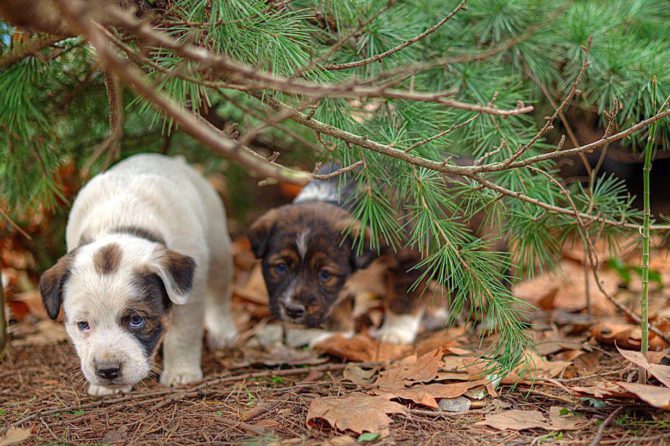
Ten years of Companion Animal Welfare in Serbia
In 2009, the Law of Animal Welfare in Serbia was established. I deliberately say “established” instead of “implemented”, because now in 2019, even after ten years, we are still waiting for this law to fully come to life.
According to many experts, the Law of Animal Welfare is one of the best in the Balkans region,and even in the EU. This is a “no kill” law. On one hand, it aims to deal with stray dog and cat population problems humanely by providing the necessary framework for the CNR (catch – neuter-release) program to develop. On the other hand, it protects companion animals from the “free will”of the owner to euthanize the dog or the cat just because they are moving or are having a baby.
Modern society recognizes the significance of companion animals because they have feelings too: they love, fear, feel pain, and they can even suffer. They provide us with comfort, emotional security and they make us smile. Having a pet today is as normal as breathing. Pets are a big part of the family: they travel with their owners, they sleep in their beds and their needs are often put before the needs of the rest of the family. They can ride in the public transport, they can lead the blind, they can be of service in the police, they can even assist in schools and hospitals. Unfortunately, we are not a modern society yet. Here, pet owners are still scrutinized by the general public – “why are you walking a dog, you should be walking a child”; “why are you feeding a stray dog, go feed a hungry child”; “ this is a public place, no dogs allowed”.
Unlike the general public, owners in our country are much more aware of their obligations of having a pet. They are becoming more and more demanding when it comes to choosing the right vet, right grooming salon, dog trainer and a pet sitting service. We have more and more pet friendly restaurants, hotels and sometimes pets are even allowed on public transport. Veterinarians who work in small animal practice are also modernizing their services by providing a more holistic approach. All of this was not the case 15 or even 20 years ago.
When dealing with welfare issues, our competent authorities are mainly focusing on farm animals and somehow companion animals seem to be neglected. There are two reasons for this – 1. farm animals are primarily in the food chain as a part of global public health 2. the current capacities of competent authorities to deal with both farm and companion animals are insufficient. The solution for this problem can be more specific regulation of companion animal welfare with e.g. National Strategy for companion animals, where both categories – owned and not owned animals will be included. This way we can try to increase capacity and competence with the involvement of expertsin this particular field, different NGO’s and small animal veterinary practitioners. The aim of thisstrategy will be to provide an efficient mechanism for implementation of legislation that we already have. Also, this way we can train a new generation of veterinary inspectors and police officers who will primarily deal with welfare issues of companion animals.
Another important issue has to do with by-laws on a local level which are often contradictory to basic animal welfare issues. If a dog is barking you should put an e-collar on him. If the dog is toclose to a neighbor’s fence you should put him on a chain. Stray dogs are allowed on the streets,
but if you try to feed them you will get fined. Your dog should wear a muzzle when walked, even though there are strays that can attack him and he has no means to defend himself. All of these measures are opposed to other laws and are not focusing on the main issue which is responsible ownership. This is a very important factor especially for a country that has a large number of stray animals, overcrowded local shelters, unregulated database of breeders and owners. We are still unable to properly address the abandonment of dogs and cats, meaning that we lack proper sanctions for those who throw their dog or a cat out on the street. This is because the competent authority on a local level does not have enough veterinary inspectors out on the field who will be able to deal with this specific issue. In order to “cut off” the source of stray animals, we need toestablish a database of breeders in the first place. Also, we need more strict regulation for micro- chipping a pet, as well as more thorough education of the public about spaying/neutering of companion animals.
Our local shelters are also facing serious problems. They are by law, “no kill” shelters, but they donot have adoption strategies, no efficient CNR program and no euthanasia protocols. As a result, they are overcrowded. Many animals are left untreated, the others are staying in the shelters for too long. The overall opinion is that the conditions in our local shelters are far from good. They do not fill out even the minimum welfare standards and this is a concerning ongoing issue. The sheltering system needs to be revised by experts and a necessary education and training on a local level need to be initiated.
As for small animal veterinary practice in Serbia, companion animal welfare issues are a new trend. Today, all around the world we have “low stress” handling techniques when it comes toexamining a dog or a cat on a table. We have a more compassionate approach by the vet, where vets are giving consultative advice to the owners, educating them how to properly handle and train their pet, and helping them to calm their pet for the exam by implementing various behaviormodification techniques. Vets, today, in small animal practice, are not “just” doctors, they are alsoeducated in the field of animal training, behavior psychology and human – animal sciences and they play an important role in general pet owner education. In Serbia, we are just beginning tocreate this kind of “new age” veterinarians. The association of small animal veterinarypractitioners in Serbia is recognizing this trend and is thriving to educate veterinarians throughout life long learning programs and continuous education, but we need more support from the authorities. For example – tail docking and ear cropping. The vet who performs these surgeries can be sanctioned. But if he refuses, the owner will go to another vet, and one will eventually do it. This is happening because there is no adequate control, so at the end, we are not making any difference by refusing to do these procedures, we are just losing clientele, and no vet is interested in doing that. But also, there is another problem – even if vets all together stop performing these surgeries, there is also a high possibility for the owner to go to a breeder or even a dog trainer and do this procedure in someone’s garage. This is why we need to emphasize that the most importantthing is that all parties involved must obey the law equally and must be controlled equally.
To sum up, if we look back in the late 90’s and in the beginning of 2000, we can say that things have changed a lot. Companion animals have became an important part of our everyday lives. They came a long way from just being chained in our back yard. The public is becoming more“pet friendly”- not looking down on you as much if you are carrying a small dog in your purse.
The veterinarians are realizing that their patient is someone’s part of the family, and they are beingmore understanding and considerate to the owner as well as to the patient. Responsible ownership is an important topic for every veterinarian when talking to a client. Stray dogs and cats on thestreets are our reality as well as an important issue, but the public and various NGO’s are morededicated to deal with this problem humanly and are not resisting CNR programs as much.
But, all of this is not enough if we lack an efficient mechanism and acting plan by competent authorities. We have the knowledge, many experts from both veterinary associations and NGO sector; we have the will, and we would like to see our authorities recognize this and make us more involved if we want to make this legislative function efficient for the benefit of companion animals.
Dunja Kovač DVM
Leader of the program “Dobrobit Životinja” – FRD Foundation CCA – Canine Certified Assessor – “Pets & Science”

Leave a reply